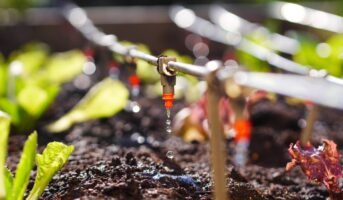The peanut plant (Arachis hypogaea), known for producing peanuts or groundnuts, is a unique legume with a distinct growth pattern. Despite their name, peanuts are not true nuts; they are the underground seeds of a tropical legume plant. Native to South America, peanuts, or groundnuts, have become a popular crop worldwide. While peanuts thrive in warmer climates, they can be cultivated indoors or in suitable regions outdoors. This comprehensive guide explores the key facts, types, characteristics and detailed steps to grow and care for peanut plants.
See also: How to grow a Soybean tree?
Peanut plant: Key Facts
| Name | Peanuts |
| Botanical Name | Arachis hypogaea |
| Common Name | Peanuts, Groundnut, Earthnut, Goober |
| Family | Fabaceae |
| Origin | South America |
| Plant Types | Annual, Vegetable |
| Height | 12 to 18 inches |
| Width | 24 to 36 inches |
| Sun Exposure | Full sun (8 hours daily) |
| Soil Type | Sandy, loamy |
| Temperature | 86-93°F |
| Soil pH | Acidic |
| Bloom Time | Spring |
| Leaves | Pinnately compound, blue/green |
| Flower Colour | Yellow, spring |
| Foliage Colour | Blue/Green |
| Native Area | South America |
Peanut plant: Characteristics
Peanut plants show a unique growth pattern, with flowers blooming above ground while the fruit develops below. The plant, about 18 inches tall, green and oval-leafed, produces delicate flowers that self-pollinate, forming “pegs” that grow into the soil. The plant embryo matures underground, resulting in clusters of 40 or more pods. With a growing cycle of four to five months, peanuts add nitrogen to the soil, enriching it for other plants.
Peanut plant: Types
Peanuts come in various types, each with distinct characteristics.
Spanish Peanuts
- Smaller pods, 2-3 small peanuts per pod
- Ideal for roasting, high oil content
- Harvest in 90-120 days
Valencia Peanuts
- Bunch-type plants with 3+ peanuts per pod
- Sweet and red-skinned, with thin shells, suitable for boiling
- Quick maturation in 90-110 days
Runner Peanuts
- Preferred by commercial growers for peanut butter.
- Peanuts grow along stems, high yield.
- Requires at least 130 frost-free days.
Virginia Peanuts
- Large-podded, 1-2 large peanuts per pod.
- Excellent for in-the-shell roasting.
- Longer growing season, 130-150 days.
Peanut plant: How to grow it?
Growing peanuts is a rewarding, low-maintenance task. Follow these steps for a successful peanut harvest:
- Select a sunny location: Choose an area with direct sunlight or use raised garden beds.
- Get quality peanut seeds: Purchase seeds from a garden centre for the best results.
- Prepare the soil: Plant kernels in a well-draining, sandy, or loamy soil.
- Ensure soil moisture: Regularly water the plants to maintain moist but not soggy soil.
- Use excess soil and mulch: Surround the plant with hills of soil or organic mulch to control weeds and aid pegs’ entry into the soil.
How to grow peanuts from seeds?
Shelling raw peanuts provides seeds for growing. Follow these steps:
- Select a sunny spot: Ensure a warm location with at least 120 to 150 frost-free days.
- Plant after the last frost: Sow seeds 1 to 2 inches deep and 6 to 8 inches apart in well-draining soil.
- Water regularly: Keep the soil moist, especially after planting and when pegs are forming.
- In colder regions, consider growing peanuts in containers or a conservatory.
Harvesting peanuts
Peanuts are ready for harvest after 120-150 days. Once the foliage turns yellow, carefully dig up the entire plant, shake off excess soil, and let it dry for two weeks. After curing, remove the pods and store them in a dry, well-ventilated area for another two weeks before enjoying your harvest.
Peanut plant: Care tips
Sunlight
Ensure at least eight hours of direct sunlight.
Soil
Opt for loose, well-drained sandy loam with a slightly acidic pH.
Watering
Provide 1 inch of water per week, avoiding overwatering.
Temperature and humidity
Peanuts thrive in high heat and humidity; soil temperature should be 18°C-21°C for germination.
Fertilisation
Peanuts fix their nitrogen; use peanut inoculant if planted in a new location.
Pruning
While not necessary, pruning can increase yield and remove non-flowering or diseased branches.
Peanut pant: Benefits and uses
The peanut plant offers a range of culinary uses and health benefits:
- Versatile culinary uses: From dry-roasted peanuts to peanut oil and peanut butter.
- Nutritionally dense: Rich in protein and healthy fats.
- Soil enrichment: As a nitrogen-fixing plant, it contributes to soil health.
- Diverse applications: Over 300 derivative products, including flour, soap making, cosmetics, lubricants.
Peanut plant: Common pests and diseases
Peanuts may face challenges from pests like red spider mites and aphids and diseases like fungal leaf spots. Regular inspection and appropriate remedies, including misting for mites and soil amendments for diseases, can ensure healthy peanut plants.
Peanut plant: Toxicity
Peanuts can trigger severe allergic reactions in some individuals, with symptoms ranging from discomfort to anaphylactic shock. Careful scrutiny of product labels is essential due to the prevalence of peanuts in various foods. Refined peanut oil typically doesn’t cause allergic reactions, but precautions should be taken with crude peanut oil.
FAQs
Are perennial peanut plants and peanut plants the same?
No, perennial peanuts (Arachis glabrata) are ornamental and lack edible seeds.
How long do peanuts last after harvesting?
Shelled peanuts last about four months at room temperature and a year in the refrigerator.
Can peanuts be grown in containers?
Yes, peanuts can be grown in containers, providing sufficient space for their underground pegging process.
Do peanuts fix nitrogen in the soil?
Yes, peanuts are nitrogen-fixing plants, contributing to soil enrichment.
What is the ideal temperature for peanut growth?
Peanuts thrive in temperatures between 86 and 93 degrees Fahrenheit.
How often should peanuts be watered?
Water peanuts regularly, especially during peg formation, but stop watering 10 days to two weeks before harvesting.
How can pests be controlled in peanut plants?
Use natural repellents like chilli powder or garlic spray and maintain a weed-free environment.
| Got any questions or point of view on our article? We would love to hear from you. Write to our Editor-in-Chief Jhumur Ghosh at jhumur.ghosh1@housing.com |
Priya Banerjee, a writer with a keen eye on the property market, she deciphers the ever-changing trends in residential real estate. Priya excels at simplifying complex real estate terms, making them easy for everyone to understand. Her well-researched advice helps buyers and investors understand complex topics.












